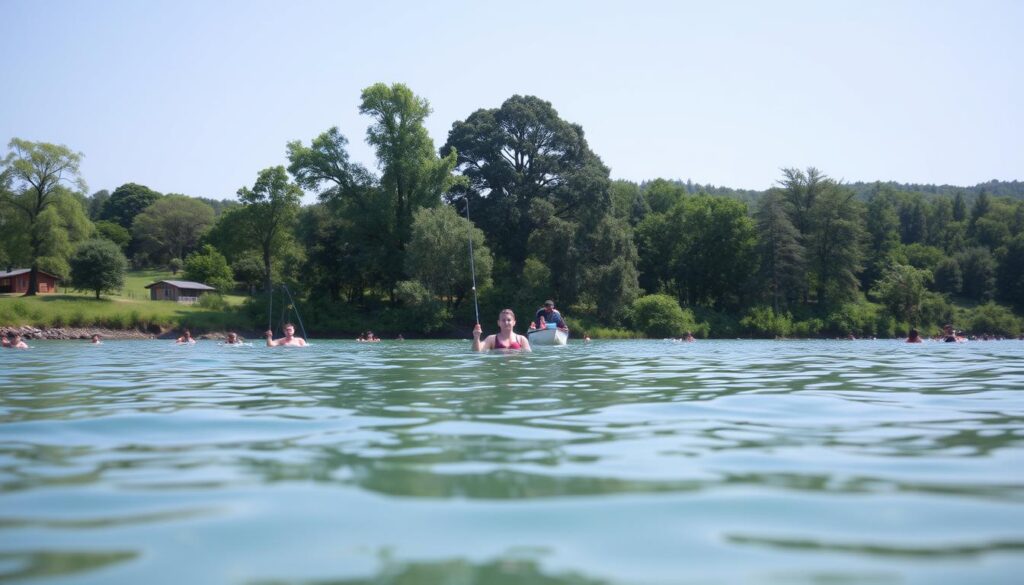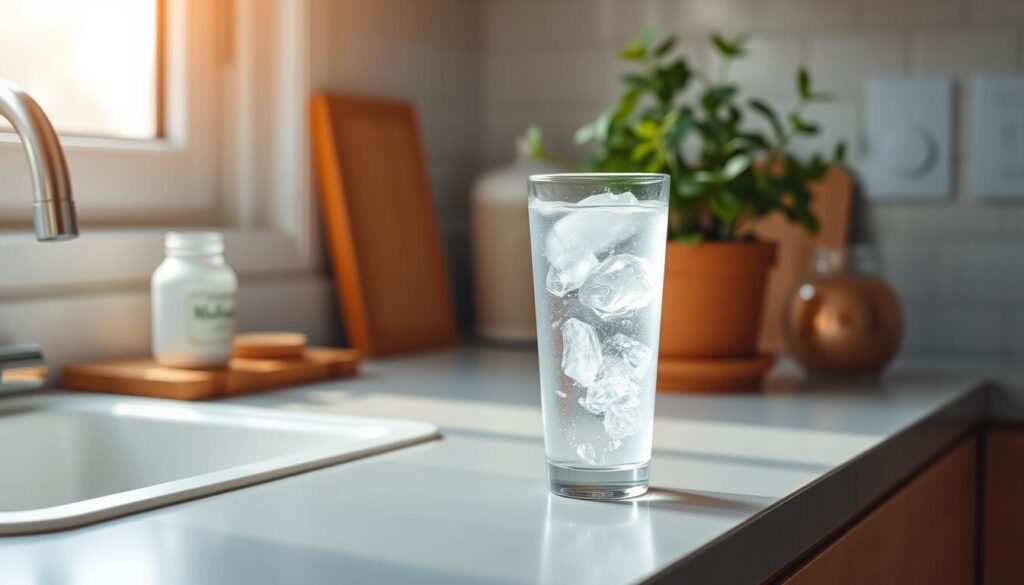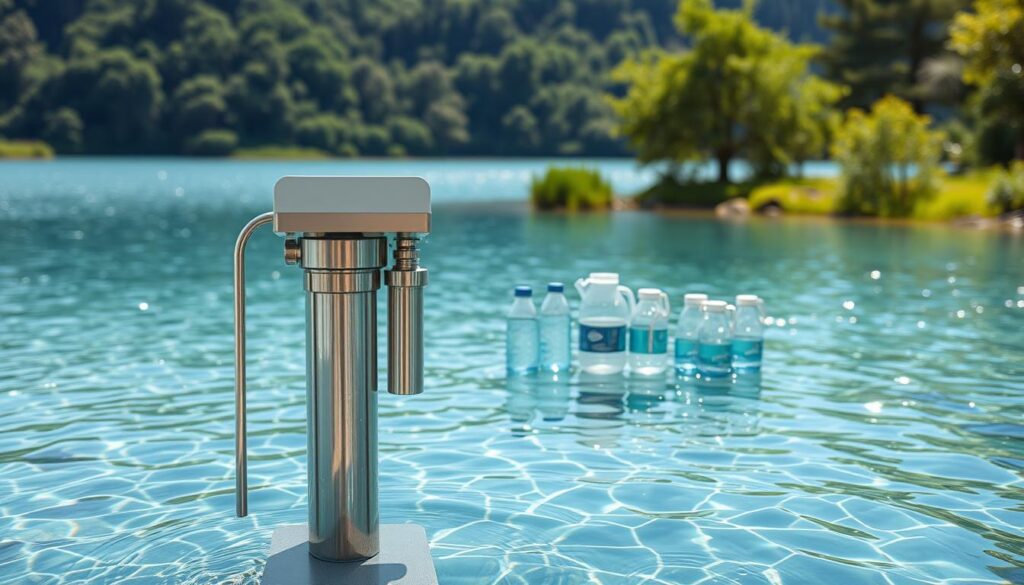Traveling to new places made me realize how important staying healthy is. One big risk I faced was getting waterborne illnesses. These can be a big problem, mainly in places with bad sanitation and hygiene.
I learned that it’s key to take steps to avoid these illnesses. Knowing the risks and being careful helps a lot. In this guide, I’ll share tips on how to stay safe and healthy while traveling.
Key Takeaways
- Understand the risks associated with waterborne diseases
- Learn preventive measures to stay healthy while traveling
- Discover ways to minimize your chances of getting sick
- Stay informed about sanitation and hygiene practices
- Take necessary precautions to ensure a safe and healthy trip
Understanding Waterborne Diseases
Let’s start by understanding what waterborne diseases are and how they affect us. These diseases come from tiny pathogens in water. They can make us very sick.
What Are Waterborne Diseases?
Waterborne diseases are infectious diseases that happen when we drink or touch contaminated water. They can be caused by many things like bacteria, viruses, and parasites.
The World Health Organization says these diseases are a big problem worldwide. They are more common in places with bad sanitation and hygiene.
Common Types of Waterborne Diseases
Here are some common waterborne diseases:
- Cholera
- Typhoid fever
- Dysentery
- Gastroenteritis
- Hepatitis A
These diseases can make you feel sick in different ways. For example, cholera can cause very bad diarrhea. This can lead to dehydration and even death if not treated right away.
Causes and Risk Factors
Waterborne diseases usually happen when we drink or use contaminated water. The main reasons include:
- Poor sanitation: Not having good waste disposal and sewage systems.
- Contaminated water sources: Rivers, lakes, and wells that have human or animal waste.
- Natural disasters: Floods and storms can make water unsafe.
- Poor hygiene practices: Not washing hands often, like after using the bathroom or before eating.
Knowing why these diseases happen is important for stopping them. As we learn more, it’s clear that teaching people and spreading awareness are key to fighting these diseases.
The Importance of Clean Water
Having clean water is key to stopping waterborne diseases, which is vital for public health. Clean water is not just for drinking. It’s also needed for keeping things clean and stopping diseases from spreading.
Water can get dirty from many places, like untreated sewage, agricultural runoff, and industrial waste. These can put harmful stuff into our water, which is bad for our health.
Sources of Contaminated Water
Knowing where dirty water comes from is the first step to fixing it. Some common places include:
- Untreated sewage from homes and businesses
- Agricultural runoff with fertilizers and pesticides
- Industrial waste, like chemicals and heavy metals
- Natural disasters that mess up water treatment systems
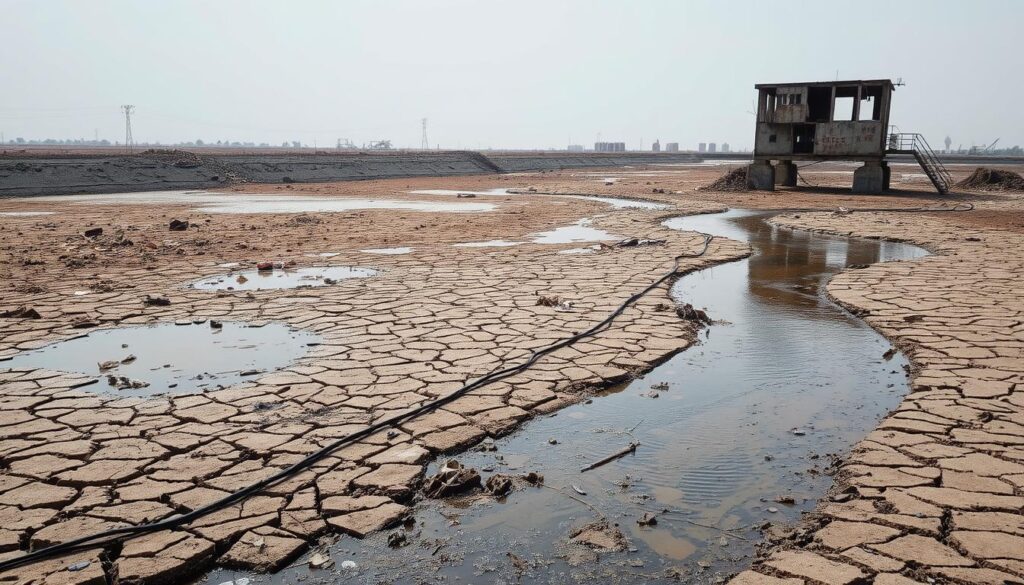
How Clean Water Benefits Health
Clean water is good for our health in many ways. It helps prevent diseases and keeps us healthy overall. Clean water is important for:
- Drinking and staying hydrated
- Keeping clean and avoiding infections
- Cooking food safely
- Enjoying activities like swimming without getting sick
By having access to clean water, we can lower our chance of getting sick. This makes our lives better overall.
Common Symptoms of Waterborne Diseases
It’s important to know the symptoms of waterborne diseases to get medical help quickly. These diseases can show different symptoms, making it hard to diagnose without knowing what to look for.
Gastrointestinal Issues
Gastrointestinal symptoms are common in waterborne diseases. You might experience diarrhea, vomiting, abdominal cramps, and fever. Cholera and giardiasis, for example, can cause severe stomach problems.
Health experts say, “Spotting these symptoms early can really help in treating waterborne diseases.”
Flu-like Symptoms
Some waterborne diseases show symptoms like fever, headache, and fatigue. These symptoms are also seen in many other illnesses. So, it’s key to think about if you’ve been near contaminated water.
Severe Health Risks
In serious cases, waterborne diseases can be very dangerous. For instance, typhoid fever can lead to high fever, delirium, and intestinal perforation if not treated. Getting medical help right away is vital.
The Centers for Disease Control and Prevention (CDC) says, “Quick diagnosis and treatment of waterborne diseases are key to avoiding serious problems.”
Ways to Prevent Waterborne Diseases
Waterborne diseases can be prevented with simple steps. I will share these steps with you in this section.
Preventing waterborne diseases requires a few key strategies. Boiling water, using filters, and chemical disinfection are common methods. Each has its own benefits and drawbacks.
Boiling Water
Boiling water is a simple and effective way to kill germs. Boiling water for at least one minute can kill most bacteria, viruses, and parasites, making it safe to drink. But, it needs fuel and can take time.
Water Filtration Systems
Water filtration systems are another good option for purifying water. They range from simple ceramic filters to complex reverse osmosis systems. The key to an effective filtration system is its ability to remove a wide range of pathogens, including bacteria, viruses, and parasites.
Here’s a comparison of different water filtration systems:
| Filtration Method | Effectiveness Against Bacteria | Effectiveness Against Viruses | Effectiveness Against Parasites |
|---|---|---|---|
| Ceramic Filters | High | Moderate | High |
| Reverse Osmosis | High | High | High |
| Activated Carbon | Low | Low | Low |
Chemical Disinfection Methods
Chemical disinfection uses chlorine or iodine-based disinfectants to kill germs in water. Chlorine disinfection is widely used due to its effectiveness against a broad spectrum of pathogens. But, it needs careful handling and dosing to avoid health risks.
When choosing a prevention method, consider cost, availability, and ease of use. 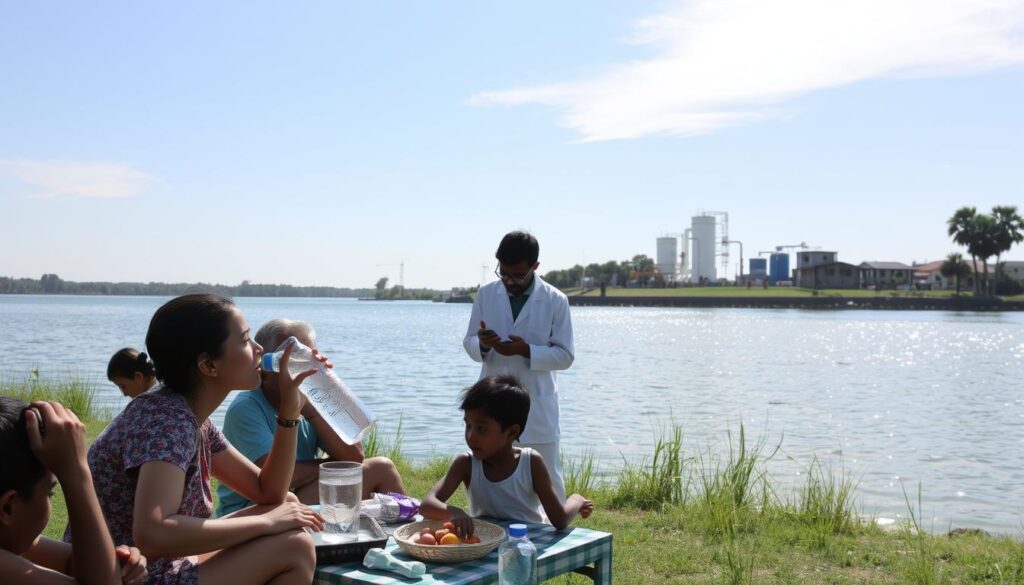
By understanding and using these preventive measures, individuals can greatly reduce their risk of getting waterborne diseases.
Safe Water Practices
Keeping water safe is key to avoiding waterborne diseases. Many practices help prevent these diseases. Let’s explore how to keep water safe.
Hygienic Handwashing
Hygienic handwashing is a top way to stop waterborne diseases. Washing hands with soap and water is vital. Do it before eating, after using the bathroom, and after touching dirty water or surfaces. This simple act greatly lowers the risk of getting sick.
Proper Food and Water Storage
Storing food and water right is also important. Keep water in clean, covered containers. Make sure food is away from things that could make it dirty. Clean these containers often to keep them safe.
Using Bottled Water Wisely
If tap water isn’t safe, bottled water is a good choice. But, make sure the seal is intact and the water comes from a trusted source. Also, think about how bottled water affects the environment.
| Practice | Description | Benefit |
|---|---|---|
| Hygienic Handwashing | Washing hands with soap and clean water | Reduces transmission of pathogens |
| Proper Food and Water Storage | Storing food and water in clean, covered containers | Prevents contamination |
| Using Bottled Water Wisely | Checking seals and sourcing from reputable suppliers | Ensures safe drinking water |
Risk Groups for Waterborne Diseases
It’s important to know who is most at risk from waterborne diseases. Some groups face a higher risk because of their health, age, or activities.
Vulnerable Populations
Children under 5, the elderly, and those with weak immune systems are very vulnerable. They can easily get sick from diseases like cholera and rotavirus.
People with weakened immune systems, such as those with HIV/AIDS or undergoing chemotherapy, are also more likely to contract severe infections. Pregnant women are another group that needs to be cautious, as waterborne diseases can pose risks to both the mother and the fetus.
Travelers and Tourists
Travelers, visiting areas with poor water quality or during outbreaks, are at a higher risk. Tourists who consume contaminated food or water without proper precautions are more likely to fall ill.
It’s essential for travelers to take preventive measures. They should drink bottled or filtered water, avoid undercooked foods, and practice good hygiene.
Outdoor Enhusiasts
Outdoor enthusiasts, including campers, hikers, and swimmers, are also at risk. Swimming in lakes, rivers, or ponds that may be contaminated with pathogens can lead to infections.
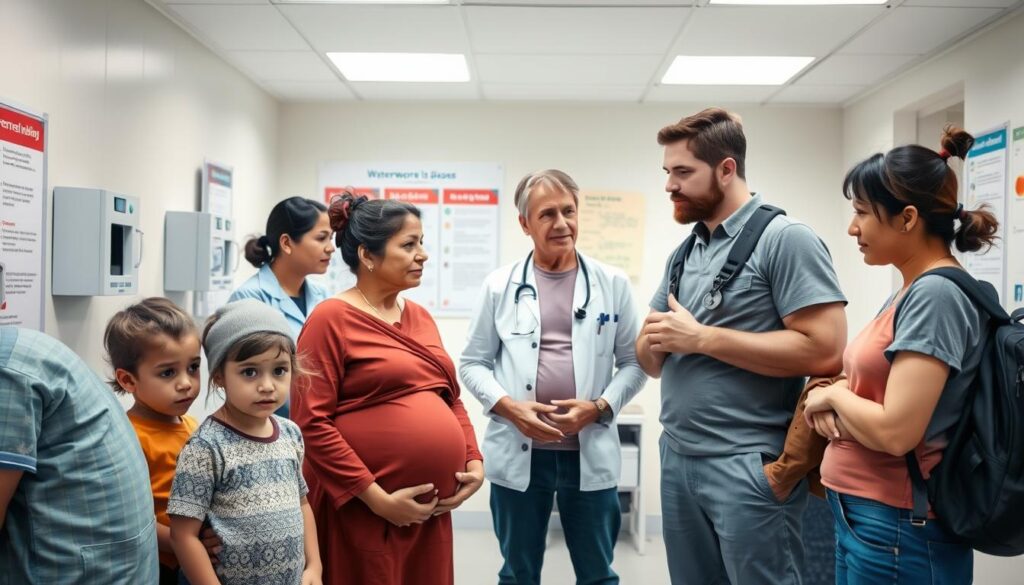
To minimize risks, outdoor enthusiasts should avoid swimming in areas with visible signs of pollution or after heavy rainfall, which can stir up contaminants.
Water Testing and Quality
Knowing the quality of your water is key to avoiding waterborne diseases. It’s important to test your water and understand the results. This ensures your water is safe to drink.
How to Test Your Water Supply
There are many ways to test your water, depending on what you’re looking for. You can use DIY water testing kits to check for common pollutants like lead and bacteria. For a detailed analysis, consider hiring a certified lab. They can test for many contaminants, including heavy metals and pesticides.
Think about where your water comes from when choosing a testing method. If you have a well or private water, regular tests are a must. Even if you get your water from the city, testing at home can help ensure it’s safe.
Interpreting Water Quality Reports
After testing your water, understanding the results can be tough. Water quality reports use technical terms. They list contaminants and compare them to safety standards set by the EPA.
To make sense of your report, look for contaminants that are above safe levels. Watch out for lead, arsenic, and E. coli. If you find any of these, you might need to get a water filter or use bottled water.
Checking your water quality is an ongoing task. Regular tests and staying updated on local contamination sources are key. This helps keep your drinking water safe.
Treatment Options for Waterborne Diseases
It’s important to know how to treat waterborne diseases to get better and avoid more problems. These diseases come from drinking contaminated water. They can be mild or serious and need the right treatment.
Over-the-Counter Remedies
For mild waterborne diseases, over-the-counter (OTC) remedies can help. These include medicines for diarrhea and salts to keep you hydrated. Always read the instructions and talk to a doctor if your symptoms don’t go away.
Seeking Medical Attention
Severe waterborne infections need medical attention. Doctors can find out what’s causing the disease and give the right treatment. This might be antibiotics for bacteria or drugs for parasites. Getting help quickly is key to avoid worse problems and stop the disease from spreading.
Long-term Management
Some waterborne diseases can cause long-term health problems like chronic stomach issues or malnutrition. Long-term management might include changing your diet, ongoing treatment, and regular check-ups. This helps manage symptoms and prevent the disease from coming back.
| Treatment Approach | Description | Examples |
|---|---|---|
| Over-the-Counter Remedies | Relief from mild symptoms | Anti-diarrheal medications, rehydration salts |
| Medical Attention | Diagnosis and treatment of severe infections | Antibiotics, antiparasitic drugs |
| Long-term Management | Managing chronic conditions and preventing relapse | Dietary adjustments, ongoing medical treatment |
Knowing how to treat waterborne diseases helps you recover faster and avoid serious issues. Whether it’s using OTC remedies, seeing a doctor, or managing your condition long-term, the right treatment is essential.
Recognizing Local Health Alerts
It’s important to know about local health alerts to protect myself from waterborne diseases. These alerts tell me about outbreaks and contaminated water in my area.
To keep up, I use different sources to track local outbreaks. The Centers for Disease Control and Prevention is one of them. They have detailed data on waterborne disease outbreaks and health alerts.
Resources for Tracking Local Outbreaks
There are many tools to track waterborne disease outbreaks locally. These include:
- Local health department websites
- CDC’s waterborne disease outbreak surveillance data
- Environmental Protection Agency (EPA) updates on water quality
Using these tools helps me stay current with health alerts. This way, I can avoid waterborne diseases.
Importance of Staying Informed
Knowing about local health alerts is key for my health and my community’s. When I’m aware of outbreaks, I can protect myself and my family.
Prevention measures include boiling water, using filters, and avoiding contaminated water sources.
By staying informed and taking these steps, I lower my risk of getting waterborne diseases.
Environmental Impact on Water Quality
It’s key to understand how the environmental impact affects water quality. This knowledge helps us fight waterborne diseases. Many things, like pollution and climate change, can harm our water by adding waterborne pathogens.
The Role of Pollution
Pollution greatly harms water quality. Industrial waste, farm runoff, and bad waste disposal add bad stuff to our water. For example, farm runoff can carry fertilizers and pesticides. These can hurt fish and make us sick.
We can make water cleaner by having better rules for industries and farms. Also, we need good waste management to keep our water safe.
Effects of Climate Change on Water Safety
Climate change also affects our water. Warmer weather and changes in rain can spread waterborne pathogens. For instance, warmer water lets some bacteria and algae grow more. This makes water diseases more likely.
Also, big weather events like floods and droughts can make water unsafe. They can overwhelm treatment plants or make water too concentrated. Knowing this helps us keep water safe as the climate changes.
By understanding the environmental impact on water, we can lower disease risks. This protects our health.
Traveling Safely: Waterborne Diseases Abroad
When you travel to new places, knowing the local water quality is key. Taking the right steps can lower your chance of getting waterborne diseases.
Exploring foreign lands makes me think about health risks. I’m careful with untreated water and undercooked food. Simple steps can keep me healthy and make my trip better.
Precautions While Traveling
Being careful with water and food is vital to avoid waterborne diseases. Here are some tips:
- Avoid drinking tap water unless it’s been treated or boiled.
- Choose bottled or filtered water when you can.
- Watch out for ice, as it might be made from bad water.
- Make sure food is well-cooked, even from street vendors.
For more info on cleaning water, check the CDC’s guide on water disinfection for travelers.
Drinking Water Safety in Different Countries
Drinking water safety changes a lot from country to country. In some places, the water is very dirty. It’s important to research your destination.
Knowing the water situation and taking the right steps can help a lot. Being informed and ready helps travelers stay healthy and enjoy their trips.
Resources for Further Information
Looking for more on waterborne diseases? There are many resources to help. Knowing where to find good info is key to staying healthy.
Useful Websites and Organizations
Many trusted groups share info on waterborne disease control. The Centers for Disease Control and Prevention (CDC) and the World Health Organization (WHO) are leaders. They offer detailed info on prevention and treatment.
How to Find Local Health Resources
Want to find local health help? Start with your local health department or their website. Health clinics and groups in your area also offer info on preventing waterborne diseases. Using these resources helps you stay informed and protect your health.
By using these resources, you can learn more about waterborne diseases. This knowledge helps you prevent them. It makes your community safer and healthier.
FAQ
What are waterborne diseases, and how are they spread?
Waterborne diseases come from drinking contaminated water or touching water with harmful germs. These germs can be bacteria, viruses, or parasites. People get sick when they drink bad water, don’t wash their hands, or play in dirty water.
What are some common types of waterborne diseases?
Common waterborne diseases include cholera, typhoid fever, dysentery, and gastroenteritis. These illnesses are caused by different germs like bacteria, viruses, and parasites.
How can I prevent waterborne diseases while traveling?
To avoid getting sick while traveling, drink only bottled or filtered water. Don’t eat ice or unpeeled fruits and veggies. Also, wash your hands often with soap and clean water.
What are the symptoms of waterborne diseases?
Symptoms can be mild or severe. They include stomach problems like diarrhea and vomiting. You might also feel flu-like, with fever and headache. In bad cases, it can be very serious.
How can I test the quality of my water supply?
You can test your water by using kits or sending it to a lab. Look for bacteria, viruses, and parasites.
What are the treatment options for waterborne diseases?
Treatment depends on the disease and how bad it is. For some, you can buy medicine over the counter. But for serious cases, you need to see a doctor. Sometimes, you need to manage it long-term.
How can I stay informed about local health alerts and outbreaks?
Keep up with local health news by following the CDC and your government’s travel alerts. This helps you stay safe.
What is the impact of environmental factors on water quality?
Pollution and climate change hurt water quality. They make it more likely for waterborne diseases to spread. Pollution comes from farms, factories, and waste. Climate change changes water temperature and how much rain we get, which affects germs.
What precautions can I take to avoid waterborne diseases while engaging in outdoor activities?
To stay safe outdoors, avoid dirty water and wash your hands often. Drink only bottled or filtered water.
Where can I find resources for further information on waterborne diseases?
For more info, check out the WHO and CDC websites. You can also look for local health resources and online guides.

